pytorch loss
Posted 东东就是我
tags:
篇首语:本文由小常识网(cha138.com)小编为大家整理,主要介绍了pytorch loss相关的知识,希望对你有一定的参考价值。
1.损失函数简介
损失函数,又叫目标函数,用于计算真实值和预测值之间差异的函数。
pytorch loss基类是_Loss ,其中_Loss又继承Module类

其中每个loss,只需要实现forward就好

其中每次训练的时候都要
loss.backward()
但是我在loss函数里没找到backward()这个函数,就有点奇怪。后来发现原来loss是一个tensor,而tensor中是有backward的,

而且是调用的autograd里面的backward
1.1 L1Loss
ℓ
(
x
,
y
)
=
L
=
l
1
,
…
,
l
N
⊤
,
l
n
=
∣
x
n
−
y
n
∣
,
\\ell(x, y) = L = \\l_1,\\dots,l_N\\^\\top, \\quad l_n = \\left| x_n - y_n \\right|,
ℓ(x,y)=L=l1,…,lN⊤,ln=∣xn−yn∣,
N是batch_size 如果没有设置reduction ,默认采用mean
ℓ
(
x
,
y
)
=
mean
(
L
)
,
if reduction
=
’mean’;
sum
(
L
)
,
if reduction
=
’sum’.
\\ell(x, y) = \\begincases \\operatornamemean(L), & \\textif reduction = \\text'mean';\\\\ \\operatornamesum(L), & \\textif reduction = \\text'sum'. \\endcases
ℓ(x,y)=mean(L),sum(L),if reduction=’mean’;if reduction=’sum’.
import torch.nn as nn
import torch
def validate_loss(input,target):
return torch.mean(torch.abs(input-target))
loss=nn.L1Loss()
input=torch.randn(3,5,requires_grad=True)
target=torch.randn(3,5)
output=loss(input,target)
print("default loss:", output)
output = validate_loss(input, target)
print("validate loss:", output)
1.2NLLLoss 多分类
https://zhuanlan.zhihu.com/p/338318581

ℓ
(
x
,
y
)
=
L
=
l
1
,
…
,
l
N
⊤
,
l
n
=
−
w
y
n
x
n
,
y
n
,
w
c
=
weight
[
c
]
⋅
1
c
≠
ignore_index
\\ell(x, y) = L = \\l_1,\\dots,l_N\\^\\top, \\quad l_n = - w_y_n x_n,y_n, \\quad w_c = \\textweight[c] \\cdot \\mathbb1\\c \\not= \\textignore\\_index\\
ℓ(x,y)=L=l1,…,lN⊤,ln=−wynxn,yn,wc=weight[c]⋅1c=ignore_index
x是输入,y是label ,w是类别权重
ℓ ( x , y ) = ∑ n = 1 N 1 ∑ n = 1 N w y n l n , if reduction = ’mean’; ∑ n = 1 N l n , if reduction = ’sum’. \\ell(x, y) = \\begincases \\sum_n=1^N \\frac1\\sum_n=1^N w_y_n l_n, & \\textif reduction = \\text'mean';\\\\ \\sum_n=1^N l_n, & \\textif reduction = \\text'sum'. \\endcases ℓ(x,y)=∑n=1N∑n=1Nwyn1ln,∑n=1Nln,if reduction=’mean’;if reduction=’sum’.
def validate_loss(input,target):
val = 0
for li_x, li_y in zip(input, target):
val+=li_x[li_y]
return torch.abs(val / len(target))
loss = nn.NLLLoss()
m = nn.LogSoftmax(dim=1)
input=torch.randn(3,5,requires_grad=True)
target = torch.tensor([1, 0, 4])
output = loss(m(input), target)
print("default loss:", output)
output = validate_loss(m(input), target)
print("validate loss:", output)
>>>
>>>
# 2D loss example (used, for example, with image inputs)
def validate_loss(input,target):
val = 0
for li_x, li_y in zip(input, target):
dim0, dim1 = li_y.shape
li_x=li_x.tolist()
li_y=li_y.tolist()
# 遍历张量
for i in range(dim0):
for j in range(dim1):
element = li_y[i][j]
res=li_x[element][i][j]
val+=res
return val / 320
N, C = 5, 4
loss = nn.NLLLoss()
# input is of size N x C x height x width
data = torch.randn(N, 16, 10, 10)
conv = nn.Conv2d(16, C, (3, 3))
m = nn.LogSoftmax(dim=1)
# each element in target has to have 0 <= value < C
target = torch.empty(N, 8, 8, dtype=torch.long).random_(0, C)
input=m(conv(data))
output = loss(input, target)
print("default loss:", output)
output = validate_loss(input, target)
print("validate loss:", output)
1.3PoissonNLLoss
真实标签服从泊松分布的负对数似然损失,神经网络的输出作为泊松分布的参数λ 。
target
∼
P
o
i
s
s
o
n
(
input
)
\\texttarget \\sim \\mathrmPoisson(\\textinput)
target∼Poisson(input)
loss
(
input
,
target
)
=
input
−
target
∗
log
(
input
)
+
log
(
target!
)
\\textloss(\\textinput, \\texttarget) = \\textinput - \\texttarget * \\log(\\textinput) + \\log(\\texttarget!)
loss(input,target)=input−target∗log(input)+log(target!)
loss = nn.PoissonNLLLoss()
log_input = torch.randn(5, 2, requires_grad=True)
target = torch.randn(5, 2)
output = loss(log_input, target)
output.backward()
1.4KLDivLoss
l ( x , y ) = L = l 1 , … , l N , l n = y n ⋅ ( log y n − x n ) l(x,y) = L = \\ l_1,\\dots,l_N \\, \\quad l_n = y_n \\cdot \\left( \\log y_n - x_n \\right) l(x,y)=L=l1,…,lN,ln=yn⋅(logyn−xn)
ℓ
(
x
,
y
)
=
mean
(
L
)
,
if reduction
=
’mean’;
sum
以上是关于pytorch loss的主要内容,如果未能解决你的问题,请参考以下文章